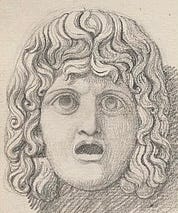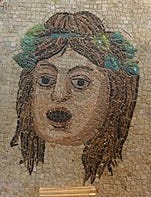This earthenware mask is on display in Warrington Museum:
It was found during excavations of the Roman settlement at Wilderspool, where the River Mersey could be crossed relatively easily, something which was important to the locals for years before the Romans came. It was also a crossroads for important Roman roads running from Chester and Middlewich as well as north to Hadrian’s Wall and beyond.
People at Wilderspool two thousand years ago made things: they worked in glass, wood, metal and clay. And one of them made this mask.
Suggestions as to what the mask was for vary: the local historian who discovered it in 1869 called it Persona Tragica, a tragic actor’s mask, but an actor’s mask made of red earthenware would be unusual, and quite uncomfortable for the actor. And the mouth just doesn’t look right, especially compared to depictions of acting masks in sculptures and mosaics.


Maybe the Wilderspool mask was decorative, or hung up to show that a play was going to be put on in the community. Maybe it was part of a religious ritual, the object of small offerings and prayers at a household shrine. I’ve even heard the suggestion that it was used to protect a workman’s face from the heat of a furnace.
It’s still my favourite artefact on display at the museum.





Home decor is my guess.